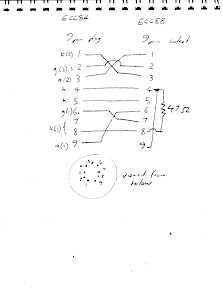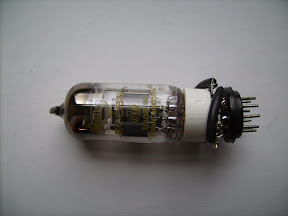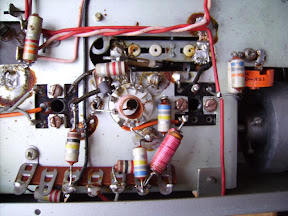Initial impressions of the first buy was that the sensitivity really is very low indeed, but it sounds great. The accepted audiophile solution is a big outdoor aerial. Fair enough, but are there alternatives, e.g. using a decent low noise RF amplifier? This was to be my first experiment with my newly acquired Trough Line 3, but then I saw an opportunity to acquire another very cheaply, albeit with no valves. Rummaging through my boxes of valves revealed that I had spares for everything, including the tuning indicator, except for the ECC84. So what is an ECC84 and did I have a suitable alternative? Looking at the circuit diagram I could see it was the first RF stage, but the circuit diagram was hard to read so I looked at the circuit for the stereo version. Hey, it uses a different valve, the ECC88, these I have.
ECC84, PCC84, ECC88, E88CC, PCC88 - what's the difference? If like me you've got a lot of old valves from old TV receivers, radios, and test equipment you probably don't have any spare ECC84s, but you may well have a few of each of the others. The good news is, they're all usable in early Trough Lines that use the ECC84, though some modification to the wiring of the Trough Line will be needed to use any of the 88s. It seems the ECC88 was an improved replacement for the ECC84, though the base connections aren't exactly the same. It also needs a slightly higher anode current. To check this without modifying the Trough Line I put together a simple adaptor. Here's the circuit.
And here's what it looks like.

And yes, it works! In fact it works very well, bringing in stations that couldn't be received at all with the ECC84. So I'm making this a permanent change to my first Trough Line. Hopefully nobody reading this will imagine I have any special powers or knowledge; all the information required to put together the adaptor can be extracted from the two circuit diagrams, but to be completely sure I checked the valve specs at the Virtual Valve Museum. Here you can also find details of the other valves I mentioned. It's worth noting that they aren't exact equivalents, since ECC84 and PCC84, etc. were designed for slighlty different uses and have different heaters.
Some explanation is possibly required regarding the heaters. The standard heater voltage for mains powered radios from about 1940 (earlier in the USA) was 6.3V. However for AC/DC sets and TVs the heaters were connected in series and so valves were designed to all draw the same current. Valves with a first letter 'E' are for parallel use at 6.3V, whereas those with a first letter
'P' are for serial use at 300mA. What you'll find is that for all these valves the heater voltage and current is within 10%, so for practical purposes they are all usable at 6.3V, and most likely all but the ECC88 are usable at 300mA (I've not tried this). Note this is not generally true for E and P valves, especially not output valves. Other heater variants are also possible, for example a UCC84 would have a 100mA heater.
Before -
 And after -
And after -
I've seen PCC88 as substitution before. Though these are radio frequency (VHF) amplifier cascode triodes they were used unstead of the last ECC82 in my Ferrograph tape recorder when it was built. I'm not sure why though. What this does show is that the two triodes in the (E/P)CC88 are the same, this doesn't seem to be the case for (E/P)CC84.
2 comments:
I'm wondering how you built the converter for the pin layout... the 9 pin sockets are really easy to find.. but I can't find anything like your little black plug-in module...
That's a good point. I've got so much old electronic "junk" I tend not to notice that so much stuff isn't available these days.
Maybe you can pick them up on ebay.
Post a Comment